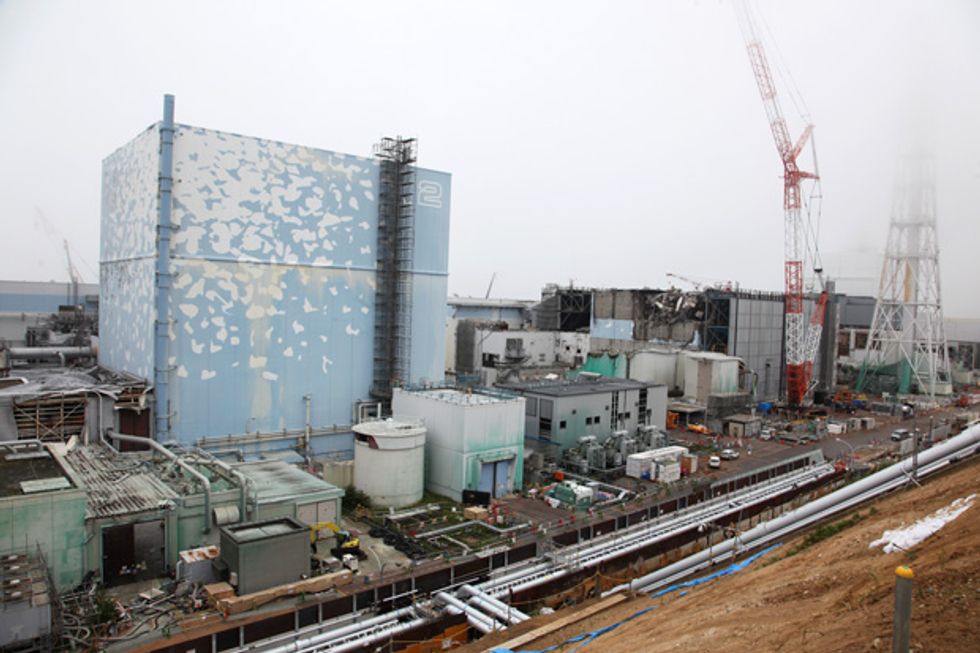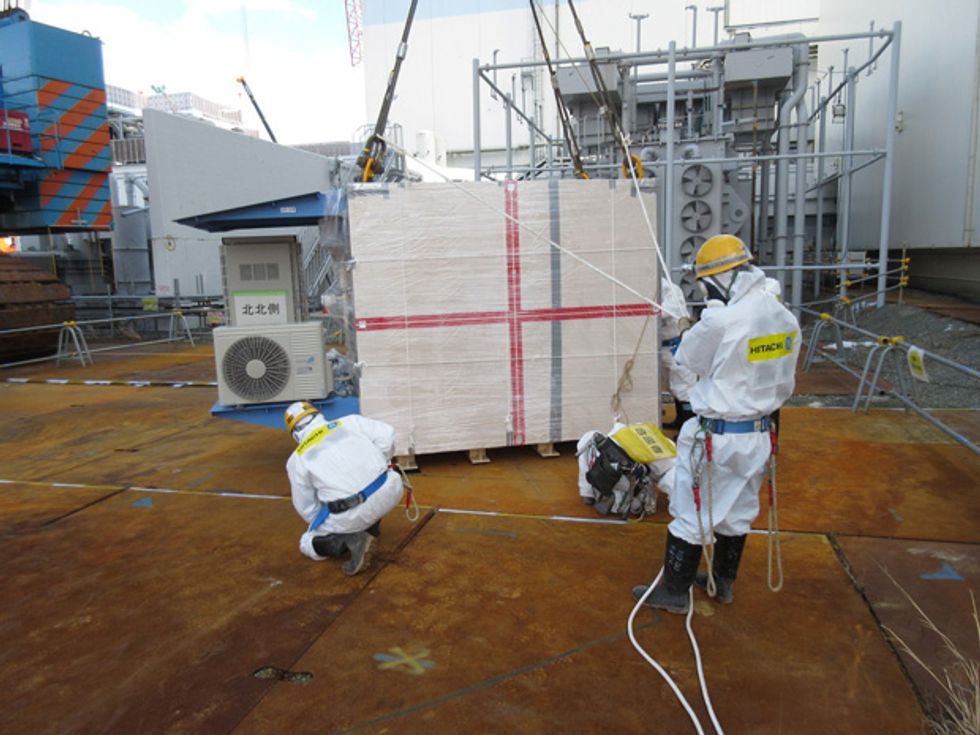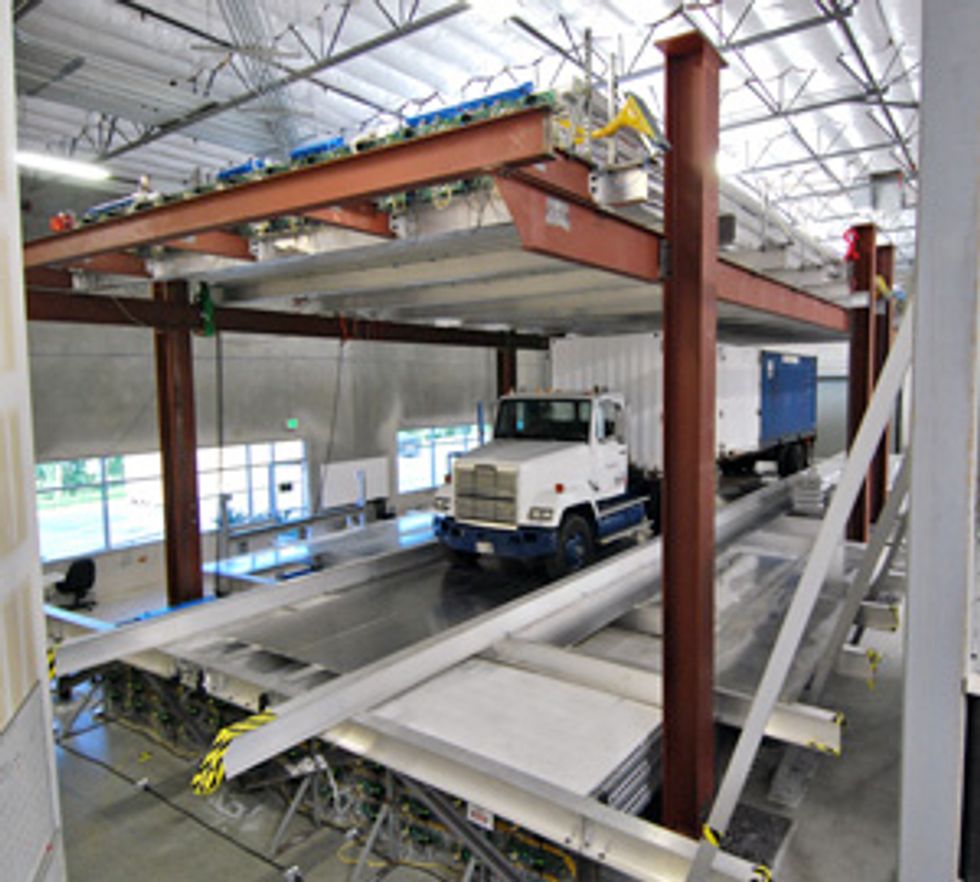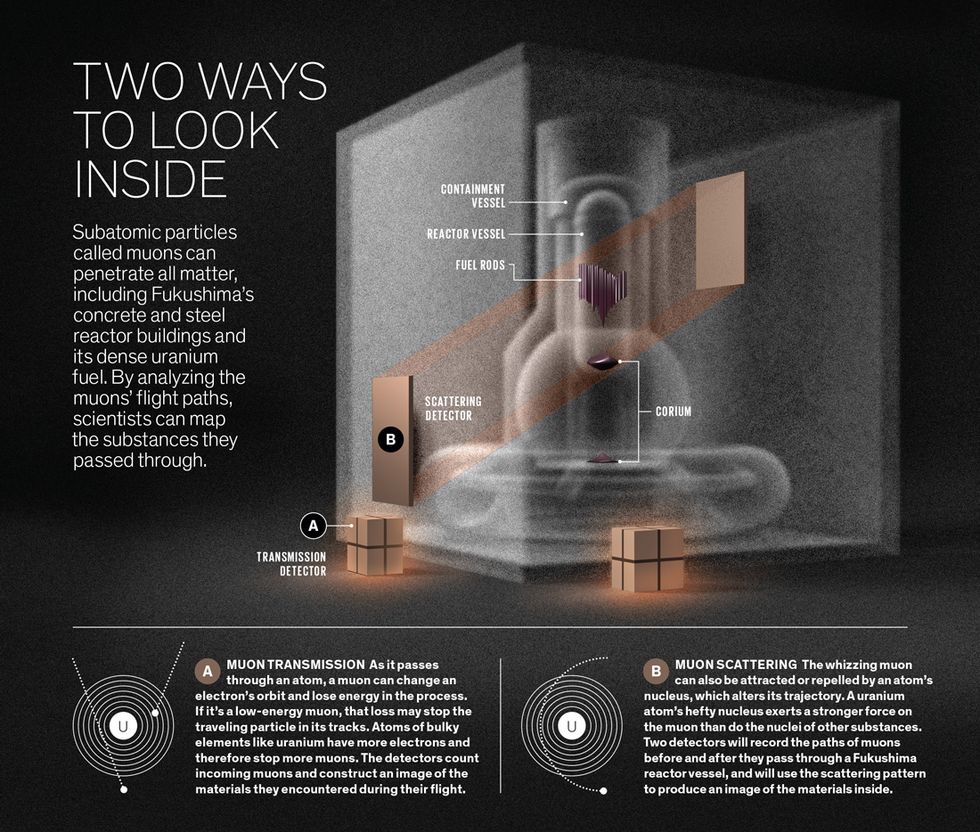Harnessing Cosmic Rays to Peer Into Fukushima’s Deadly Reactors
Physicists use particles called muons to map the melted nuclear cores

They come from outer space. Some are born within the cozy confines of our solar system, surging forth when our sun flares up, as it routinely does, with geysers of plasma. Others have traveled from unfathomably distant reaches beyond our Milky Way galaxy, where stars at the end of their lives went supernova with mighty and sustained blasts.
They are cosmic rays: streams of electrically charged subatomic particles that perpetually bombard Earth. When they hit the thick blanket of gas that surrounds and protects our planet, they collide with atoms and split into even tinier fragments that rain down to the ground. Physicists call these assortments of particles “air showers.”
One plentiful particle in these showers is the energetic muon. And here on Earth these infinitesimal specks of matter might be the answer to a very big problem called Fukushima.
Five years ago next month, the Japanese nuclear power plant Fukushima Daiichi was torn apart by meltdowns or explosions in four reactors. IEEE Spectrum has previously told the story of that horrific accident, the second worst in nuclear history: Shifting tectonic plates in the Pacific Ocean triggered a massive tsunami that battered Japan’s coast and inundated the nuclear plant, knocking out the power systems required to pump cooling water over the reactor cores. Deprived of coolant, the fuel rods in the cores of three of the plant’s six reactors melted down.
Workers struggled courageously for months to stabilize the wrecked facility, trying to establish a continuous flow of water into the reactor vessels to keep the melted cores cool—no easy task when the perforated vessels were leaking like sieves. It took four months, until July 2011, for Tokyo Electric Power Co. (TEPCO), the utility company that runs the plant, to install the pumps and water recycling systems necessary for the government to declare the plant “stable.” In December 2011, the authorities agreed that the plant had achieved “cold shutdown,” meaning that reactor conditions made it impossible for nuclear fission reactions to start up again in the cores.

Those milestones may make it sound as if the Fukushima crisis has been resolved. It hasn’t been. Should the circulation systems at Fukushima Daiichi break down tomorrow, water levels in the leaky reactor vessels would drop, exposing the nuclear fuel. In a flash, Japan would again be in the midst of a nuclear disaster.
To eliminate such a possibility, TEPCO has pledged to remove all nuclear fuel, including every drop of the melted stuff, and to completely dismantle the power plant. The company estimates this mammoth decommissioning project will likely take 40 years. Why such a long timeline? Because some of Fukushima’s challenges require the invention, design, testing, and implementation of entirely new technologies.
The main problem lies in and under the three reactors that experienced meltdowns. (A fourth reactor building was shattered by an explosion, but its nuclear fuel had been removed earlier for routine maintenance and wasn’t damaged.) During the first terrible days of the accident, the uranium fuel rods inside Fukushima Daiichi’s reactors 1, 2, and 3 overheated, slumped, oozed, and finally dripped down to the bottom of the reactor vessels. Some of this radioactive sludge probably melted through those 14-centimeter-thick steel vessels and spilled onto concrete pads below, making the cleanup task much more formidable.
Or maybe it didn’t—and that’s the issue. To this day, TEPCO doesn’t know exactly where this deadly material ended up. The monitoring equipment inside the reactors was destroyed in the accident, and workers can’t go near the crucial areas to conduct inspections. TEPCO hasn’t yet been able to take measurements in the most dangerous areas, and has already found hot spots around those concrete pads where radiation reaches the lethal level of 5 sieverts per hour. TEPCO’s technology partners are busily developing robots that can go in to survey the scene, but rubble-filled buildings with narrow hatches and stairs make it tough for bots to get around.
Lake Barrett knows a lot about cleaning up a nuclear disaster: He managed the decommissioning of the Three Mile Island reactor after its 1979 accident, the worst nuclear accident the United States has ever seen. He’s now a consultant for TEPCO and regularly flies to Japan to advise the company. What will it take to defuel Fukushima’s reactors? “It starts with investigative diagnostics,” Barrett says. “They’ll make fundamental engineering decisions based on the diagnostics.” He notes that TEPCO’s timetable calls for the company to decide on a defueling procedure in 2017—an optimistic goal, he says, given the current state of knowledge. “We’re coming up on five years and we don’t have a lot of information yet,” he explains.
Until TEPCO figures out the exact location of every radioactive glob of melted metal, the overseers can’t make a plan to remove the fuel from the reactors and proceed with the decommissioning. They’re stymied. And that’s where the muons come in. An imaging technology that makes use of these humble particles may be the investigators’ best hope for getting a look at the lethal hearts of Fukushima’s ruined reactors.

A bland office park in the suburbs of San Diego seems an unlikely place to encounter ardent fans of subatomic particles. But inside the offices of Decision Sciences, an 11-year-old company headquartered there, you can’t throw a piece of chalk without hitting a physics Ph.D. CEO Gene Ray, for example, picked up a doctorate in theoretical physics before embarking on a 40-year business career. “But I haven’t used it much,” he demurs.
So when it comes time to talk cosmic rays, the CEO happily yields to his vice president of analytics, Konstantin Borozdin, who trained in experimental nuclear physics in Moscow and worked for a decade as an astrophysicist at Russia’s Space Research Institute. The muons produced from cosmic rays, Borozdin explains, aren’t usually objects of interest for theoretical physicists. The muons that shower the Earth from the upper atmosphere don’t interact strongly with other particles, so they pass right through most matter. Look at your hand for one second; statistics say a muon has whizzed through it.
For most physicists, they’re like static in the signal. “In the underground detectors that look for very rare particles, muons are a nuisance,” Borozdin says. “They try to shield from them.”
Borozdin got interested in muons when 9/11 blew away America’s peaceful haze. By that time he was on staff at Los Alamos National Laboratory, in New Mexico, investigating cosmic rays. Los Alamos, the storied birthplace of the atomic bomb, received a special call from the U.S. government after the 9/11 attack. “They asked us to look for technologies that could address nuclear terrorism,” Borozdin remembers. “They wanted ways to detect nuclear weapons that someone might try to smuggle into the country.” Borozdin and his colleagues realized that those nuisance particles, the ubiquitous muons, could be used in imaging systems that would spot nuclear materials.
To explain the principles at work, let’s start with high school physics. Recall that an atom is mostly empty space, with a hefty nucleus surrounded by a cloud of diminutive electrons. Most of the time, a passing muon streaks through the atom’s space unimpeded, but occasionally it interacts with the atom’s constituent particles. In one kind of interaction, the muon, which carries either a positive or negative electric charge, either pulls or pushes a negatively charged electron out of its normal orbit. That process causes the muon to lose a few electron volts of energy and slow down.
Some decades back, physicists came up with a basic imaging method to take advantage of these electron interactions, focusing on low-energy muons that lose enough energy to halt them in their tracks. This technique got an exotic tryout in 1968, when a team of physicists installed a detector inside the base of an Egyptian pyramid [pdf]. The detector counted incoming muons and traced their paths back through the pyramid to determine whether they’d traveled through solid limestone, where densely packed atoms would cause more low-energy muons to stop, or the air of a secret chamber, which would allow more to whiz through. After several months of analyzing the data, the physicists got their answer: no hidden chamber (and hence no hidden treasure).

But there’s another and more subtle signal that can be teased out of the interplay of particles. If a speeding muon passes close enough to the nucleus, which carries a positive charge, the muon is either repelled or attracted. That interaction alters the direction of the muon’s flight. You may remember that each element in the periodic table is defined by the number of protons in its nucleus; helium has 2 protons, for example, while uranium has 92. Now imagine two muons, one flying through a helium-filled balloon and another zipping through a chunk of uranium ore. The muon passing through uranium experiences a stronger repulsion or attraction from the hefty nucleus, and is pushed or pulled farther off course.
Borozdin’s Los Alamos group saw potential here. By analyzing how muons scattered after passing through a material, they could determine what that material was. In a breakthrough 2003 report, published in Nature, they suggested that detectors based on muon scattering could, for example, distinguish “a block of uranium concealed inside a truck full of sheep.”
Decision Sciences was soon formed to turn the concept into a commercial technology. Borozdin helped the company develop its scanning system, and he officially joined the staff in 2014. The system uses two detectors: one above the object of interest to register the incoming muons’ trajectory, and one below to record the scattering. Decision Sciences began marketing its scanners to cargo ports and borders that need to screen for nuclear materials, extolling the system’s superiority to existing technologies that use X-rays or gamma rays: Muon-imaging systems can look through thick layers of lead and steel, and they don’t make use of a dangerous radiation source.
Then, in March 2011, Fukushima Daiichi melted down.
After bringing a measure of stability to the crippled reactors, TEPCO has been striving to characterize the mess they have become. Roboticists at Japan’s major tech companies are developing unique shape-shifting bots that can survive the site’s lethal radiation and navigate the reactor buildings’ complex layouts. Last year TEPCO sent the first robots into the containment vessels, the concrete and steel structures that surround the reactor vessels.
TEPCO has deemed these robot excursions a success (including one in which a bot got stuck inside), and plans to continue them. But no robot has yet approached the centers of the containment vessels, where thick concrete pads sit directly under the reactor vessels. If nuclear fuel melted through the reactor vessels (a near certainty in reactors 1 and 3), that’s where it landed.
Barrett, TEPCO’s decommissioning consultant, says critical questions must be answered about the breach of the reactor vessels: “Was it a slower flow, or a catastrophic blowout? How much water was on the floor of the containment vessel when it breached through? Did it flow horizontally, like the lava flow from volcanoes?” What’s more, in the superheated conditions during the meltdown, the nuclear fuel must have mixed with other disintegrating reactor components to form an unpredictable substance that nuclear specialists wryly refer to as corium, he says. “Uranium, steel, lead, debris, concrete, handrails, electric cables, aluminum—it’s going to be a real agglomeration.”
Muon imaging may be the best way to look inside Fukushima’s deadliest spaces and find answers. In 2011, two teams of physicists came to this conclusion and started building muon detectors specifically for Fukushima Daiichi. Japanese researchers at the High Energy Accelerator Research Organization (known as KEK) constructed a system that uses muon transmission imaging, the same type of system used in the Egyptian pyramid. In a separate effort, Toshiba, a major contractor for TEPCO, asked Decision Sciences to build an instrument based on its muon-scattering system.
In February 2015, TEPCO debuted the KEK system at reactor 1, setting up the detector outside the reactor building and letting it collect muon data for about 90 days. A TEPCO spokesman says the images verified the company’s working assumptions about the behavior of reactor 1’s fuel load—namely, that all of it melted and flowed downward. The problem is that the images reveal the interior of the reactor building only in broad strokes. Barrett says it’s hard to imagine that these fuzzy images will help engineers make serious decisions about defueling operations. “The data coming out of it is pretty crude,” he says. Nevertheless, TEPCO plans to use the KEK system to study reactor 2 soon.
The Decision Sciences system currently sits in storage at a Toshiba research center in Japan, where it has been calibrated and could be used whenever TEPCO wishes. The system has already been tested on a small-scale mock-up of a Fukushima reactor at Los Alamos, and on a working research reactor at the Toshiba facility. The results of those tests, say Borozdin and Ray, bode well for the real trial of the technology at reactor 2, which TEPCO initially scheduled for mid-2015.
Yet the device wasn’t tested at Fukushima then, and instead still waits in storage. Surprisingly, TEPCO won’t specify a timeline for its use. As this article goes to press, a TEPCO spokesman would say only that the KEK device will be given priority at reactor 2, and that the Decision Sciences system will be installed “depending on the status of on-site work.”
The Decision Sciences system’s two detectors can’t be placed directly above and below the reactor vessel, so they’ll be situated at a slant: one detector in the reactor building above and to the side of the vessel, the other outdoors, below and on the opposite side. Enough muons fly down from the atmosphere at an angle, the Decision Sciences physicists say, to provide meaningful results. They estimate that approximately 500 to 1,000 muons will speed through both detectors each second, which could provide, within a week, a useful image of the reactor core or the puddle of corium in the containment vessel. The longer the system is left in place, the more fine-grained the results will be.
Borozdin recalls his tour of the wreckage of Fukushima Daiichi in 2012. During a discussion of the reactor buildings’ conditions, the site director mentioned the 40-year decommissioning plan [pdf] that TEPCO had mapped out. “He said that if they knew the location of the fuel, this road map could be reduced by at least 10 years,” Borozdin says. That’s a bold statement, which TEPCO won’t now confirm. It’s also a rare instance of good news emerging from the Fukushima site.
In the enormous task of decommissioning Fukushima, one question gives way to more: Once the nuclear fuel has been located, TEPCO must determine how it can be safely broken into bits, hauled out, and packed into protective canisters. The company’s provisional plans call for a “wet” defueling procedure that mimics the method used at Three Mile Island: Each containment vessel would be filled with water to the brim, providing more protection for workers as they drill down to break up the corium.
However, Barrett notes that the condition of the containment vessels is another big unknown. Damaged by the accident’s meltdowns and explosions, these vessels are obviously leaking: TEPCO must continuously add water through input pipes and pump water out of the reactor buildings’ basements to keep the radioactive mess submerged. Before TEPCO can plan a wet defueling, it must determine whether all the leaks in the containment vessels can be identified and patched. Only then could the containment vessels be flooded. “Until we get the diagnostics done, it’s hard to know which defueling procedure will work,” Barrett says. He’s counting on new robots—transformer bots, pipe-crawling bots, underwater bots, and more—to conduct the necessary inspections.
Barrett and many other experts now suspect that these inspections will show the wet defueling option to be infeasible, which means TEPCO will have to develop a plan for a “dry” fuel removal. Such a procedure might require remotely operated tools that could attack the corium from the side and cut it into pieces, along with water sprays to keep the radioactive dust down.
That method would be extraordinarily complicated, and it’s never been done before. But where others might see impossibility, Barrett sees another challenge. “We put a man on the moon; we can certainly defuel these things,” he says. “We just have to develop the technology to do it.”
This article appears in the March 2016 print issue as “From the Cosmos to the Core.”
